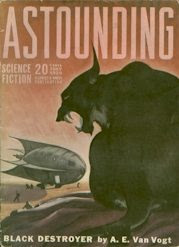 The Book of the Week is the first edition of The Jungle by Upton Sinclair. This book was published exactly 100 years ago by Sinclair's own Jungle Publishing Company. The Jungle was by far the most successful and important of Upton Sinclair's 90+ books. While the socialist state Sinclair tried to promote in The Jungle did not come to pass, the book's nauseating depiction of meat packing plants was instrumental in prompting the Pure Food and Drugs Act and the Meat Inspection Act, important precedents for government oversight of the economy. (Ironically, it was the major meat packers who lobbied for these acts, hoping to counteract the huge drop-off in sales they experienced after The Jungle came out. Sinclair opposed the legislation.)
The Book of the Week is the first edition of The Jungle by Upton Sinclair. This book was published exactly 100 years ago by Sinclair's own Jungle Publishing Company. The Jungle was by far the most successful and important of Upton Sinclair's 90+ books. While the socialist state Sinclair tried to promote in The Jungle did not come to pass, the book's nauseating depiction of meat packing plants was instrumental in prompting the Pure Food and Drugs Act and the Meat Inspection Act, important precedents for government oversight of the economy. (Ironically, it was the major meat packers who lobbied for these acts, hoping to counteract the huge drop-off in sales they experienced after The Jungle came out. Sinclair opposed the legislation.)The Jungle was at first turned down by several publishers put off by its harsh tone ("One feels that what is at the bottom of his fierceness is not nearly so much desire to help the poor as hatred of the rich," said one internal memo at Macmillan), so Sinclair decided to publish it himself. Sinclair received some 5,000 prepaid orders, which allowed him to cover the costs of printing The Jungle himself and also prompted it to be picked up by Doubleday, for whom it quickly became a runaway bestseller. The initial print run by the Jungle Publishing Company included the copies sent to those who made the prepaid orders, with a sticker thanking them for making it possible to publish the book. The Book of the Week does not have this "Sustainer's Edition" label, but has all other points of the first state of the first edition rather than the Doubleday second state: Jungle Publishing and not Doubleday is listed as the publisher on the spine; the cover shows the clasped hands socialist emblem, which was removed from the Doubleday edition; and there is no printer's error on the copyright page as there is in the second state.
First state first editions of The Jungle in fine condition regularly sell for several hundred dollars. The Book of the Week is nowhere near fine condition, with frayed boards, loose hinges and a badly faded cover (you can barely make out the cover image of a smoky factory); still, it is worth plenty more than the two dollars I paid for it. I found this book at a recent sale by a local used bookshop (Books Unlimited on Colorado Boulevard in Denver), which took advantage of a vacancy next door to clear out the books wasting away in boxes in its warehouse. They had two large rooms filled with utter crap, with a couple gems hiding underneath the crap, including this first edition of The Jungle. (The other gem I found will be next week's Book of the Week.)
Such needle-in-a-haystack finds are what bibliophiles like me live for. This is more than a little irrational. I will never read this copy of The Jungle, and if I did, I would find it has all the same words as the copies sitting on the shelves of the Barnes & Noble across the street. This copy is certainly more valuable than those, but since I will never sell it, so what? The best explanation I can give is, if you have a passion for books, dusty old used book stores are sort of like an endless Easter Egg hunt for adults.




